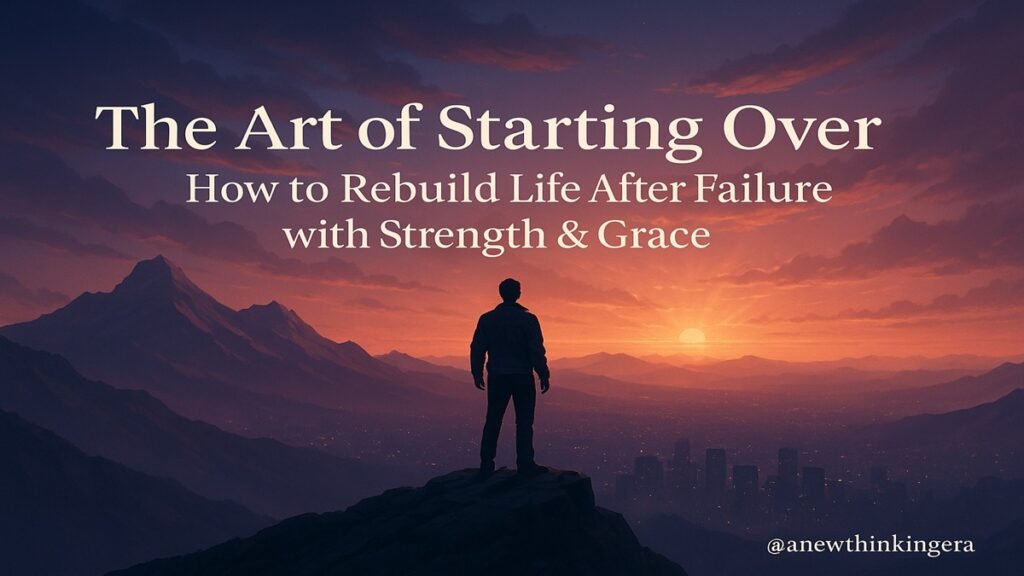
Table of Contents
When Life Breaks You, It’s also Rebuilding You
How to Rebuild Life After Failure: There comes a moment in everyone’s life when the world goes quiet — not the peaceful kind of silence, but the heavy one that follows failure. A job is lost. A dream collapses. A relationship ends. And suddenly, everything that once made sense feels shattered.
But here’s a truth often overlooked — failure isn’t the opposite of success; it’s a part of it.
Every person who’s ever created something meaningful has known defeat, doubt, and the sting of starting over.
“Every comeback begins with courage — just like we explored in our post on Never Give Up Motivation Quotes.”
This article isn’t about pretending pain doesn’t exist. It’s about learning to walk through it with strength, grace, and renewed faith in yourself. Because sometimes, when life brings you to your knees, it’s only helping you find the ground you’re meant to rise from.
📥 Download your free worksheet: “My 7-Day Rebuild Plan” — designed to help you reflect, plan, and rise again with clarity
1. Facing Failure with Honesty: The First Step to Freedom
(I). What Is Failure?
Failure is not the opposite of success — it’s part of the journey that leads to it. It isn’t a full stop; it’s a comma that asks you to pause, reflect, and rewrite your story differently. At its core, failure means a result that didn’t match your expectations. But the real meaning lies beyond outcomes — it lies in what you learn from them.
Every time you fail, life isn’t rejecting you; it’s redirecting you.Think of failure as a feedback system. It shows what’s not working, so you can grow wiser, stronger, and more creative. The most successful people, from inventors to artists, leaders to dreamers — didn’t escape failure; they used it as fuel.
“Failure is simply the price we pay for clarity and strength.”
Without failure, success would be shallow, because it’s failure that gives victory its true value.
How People React to Failure
When failure strikes, people respond in one of two ways i.e. emotionally or evolutionarily.
The Emotional Reaction: Fear, Shame, and Withdrawal
Many people see failure as a reflection of their self-worth. They internalize it , “I failed, therefore I am a failure.” This reaction often leads to:
- Self-doubt: Questioning one’s ability or intelligence.
- Comparison: Feeling inferior to others’ success stories.
- Avoidance: Losing courage to try again.
This emotional response is human, but if left unchecked, it becomes a mental prison. You begin to live in the echo of “What will people think?” instead of “What can I learn?”
The Evolutionary Reaction: Reflection, Learning, and Reinvention
Then there are those who transform failure into growth. They see it not as an identity, but as information. Their questions sound different:
- “What went wrong?”
- “What did this teach me?”
- “How can I adapt and improve next time?”
These people bounce back faster — not because they’re fearless, but because they’ve trained their minds to find meaning in mistakes. They evolve emotionally, professionally, and spiritually every time they fall. Instead of giving up, they level up.
Do You Want to Transform Your Dreams into Reality ?
What if your thoughts could shape not just dreams, but real achievement? Dive into simple steps, surprising truths, and daily rituals that turn goals into outcomes.
Explore Manifestation Practices →The Truth About Failure:
Failure doesn’t define your worth, your response to it does. Every rejection is a redirection, every mistake a map to wisdom. What breaks one person can build another, it depends on how you frame it. So the next time you fail, don’t bury it. Study it. Don’t let it break your confidence; let it sharpen your clarity.
“You haven’t failed when you fall — you’ve only failed if you refuse to rise.”
(II). Why Failure Is the Hidden Teacher:
Failure has a voice — quiet, humbling, and often ignored. It doesn’t shout lessons like success does; it whispers truths that only the patient can hear.
Most people fear failure because they mistake it for a verdict. But in reality, failure is a curriculum, one that no classroom can replace. It strips away illusion, pride, and assumption, leaving behind only what’s real.
When you fail, life is not punishing you; it’s mentoring you privately. It’s showing you what needs refinement, not what needs regret. Failure teaches clarity. It shows what doesn’t belong in our story — false goals, rushed dreams, or borrowed ambitions. It forces us to strip away pride and rediscover what truly matters.
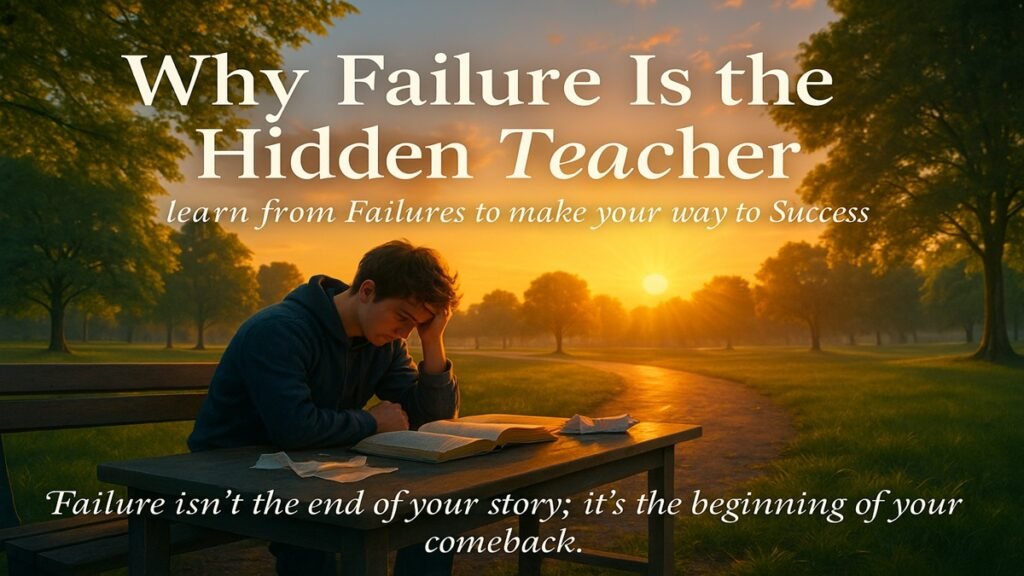
The Wisdom Inside Every Defeat:
Think about a child learning to walk — they fall hundreds of times but never label themselves as “failures.” Every fall simply means they’re figuring out balance. Adults, however, let ego get in the way. We fall once and decide we’re unworthy. But the truth is simple: falling isn’t failing; staying down is.
Failure forces you to confront your habits, your comeback mindset, and y
our resilience. It turns vague dreams into disciplined action and transforms fragile motivation into inner strength.
“Failure doesn’t destroy you — it defines the edges of your potential.”
What Failure Teaches That Success Cannot
- Humility — it reminds you that there’s always more to learn.
- Clarity — it helps you see what truly matters when the noise of achievement fades.
- Innovation — most breakthroughs are born from broken attempts.
- Endurance — resilience isn’t built on comfort; it’s built on collapse and recovery.
Failure is as a Foundation, Not Finale:
When Thomas Edison was asked about his 1,000 failed attempts before creating the light bulb, he said,
“I didn’t fail 1,000 times. The light bulb was an invention with 1,000 steps.”
That’s the mindset of a visionary, someone who treats each setback as progress disguised as pain. Your failures are not final grades; they are field notes for your next success story. Learn, adjust, and move forward, that’s how wisdom is earned.
(III). Letting Go of Shame of Failure:
Failure itself doesn’t destroy us — shame does. It’s that silent, invisible weight that whispers “You’re not good enough,” even when no one is watching. Shame is more than guilt; guilt says “I did something wrong,” but shame says “I am something wrong.” And that’s where healing must begin — by separating who you are from what happened.
Most people don’t get stuck because they failed — they stay stuck because they can’t forgive themselves. Shame whispers, “You’re not enough.” But healing begins when you answer, “I’m human, and I’m learning.”
Letting go of shame doesn’t mean ignoring mistakes; it means accepting that every fall holds a lesson. Write it down. Feel it. Learn from it. Then leave it where it belongs in the past.
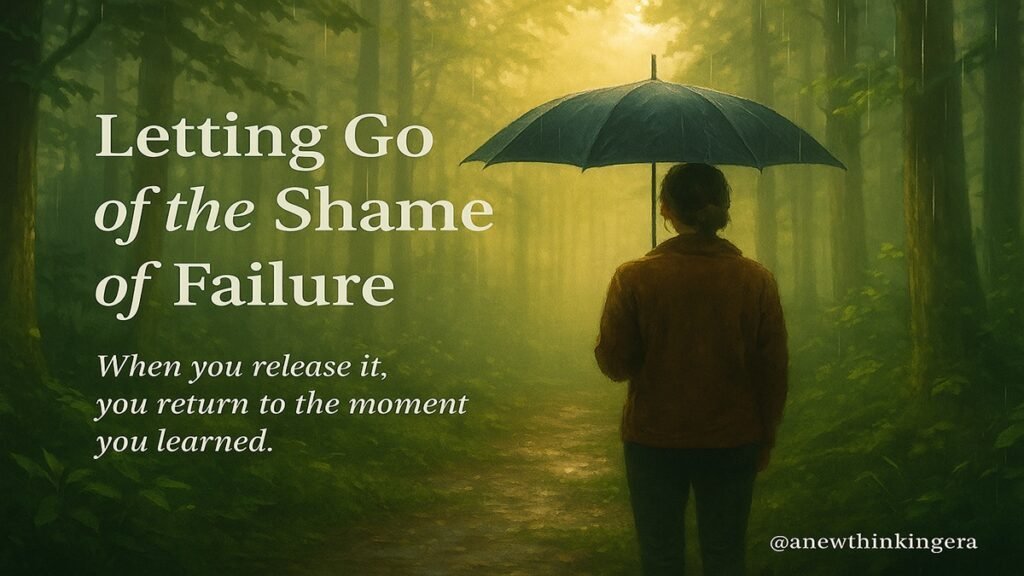
The Hidden Trap of Shame Due to Failure:
When we fail, a career loss, a dream that fell apart, or a personal mistake, our first instinct is to hide.
We withdraw from people, stop sharing ideas, stop trying. We assume others are judging us as harshly as we judge ourselves. But the truth is — most people aren’t thinking about our failure; they’re busy fighting their own.
Shame grows in silence, but it loses power when spoken aloud. The moment you tell your story with honesty, not excuses, shame begins to dissolve. Vulnerability is not weakness — it’s self-respect in motion.
“When you share your scars, they stop being wounds and start becoming wisdom.”
How to Free Yourself from Shame happens from Failure:
- Name It Without Fear: Write down what you’re ashamed of. Seeing it on paper removes its mystery.
- Speak It Safely: Talk to someone you trust — a friend, mentor, or therapist. Connection heals what isolation hides.
- Reframe the Story: Instead of “I failed,” say “I tried something brave.” Every risk is proof of courage.
- Forgive Your Old Self: The one who made mistakes didn’t know what you know today. That version of you deserves compassion, not punishment.
- Celebrate Progress: Don’t wait for perfect outcomes. Celebrate attempts, lessons, and tiny victories.
Why Letting Go Matters to free yourself from Shame:
When you hold on to shame, you stay frozen in the moment you fell. When you release it, you return to the moment you learned. The mind quiets, the heart opens, and your energy returns to build again.
Letting go of the shame of failure doesn’t mean erasing the past — it means reclaiming your power from it. Because shame cannot survive where self-acceptance lives.
“You can’t rewrite the past, but you can stop letting it write your future.“
2. Mindset Reset — Turning Pain into Power
When everything seems lost, the mind becomes your battlefield. It’s not the event that destroys you , it’s the meaning you attach to it. This is where your strong mindset decides whether pain will become your prison or your power.
Psychologists call it cognitive reframing, the art of changing how you interpret what happened. You can’t always control what life brings, but you can control how you see it. That single decision separates those who grow stronger from those who stay stuck.
“Pain is not punishment; it’s preparation.”
— Every setback is silently shaping your strength.
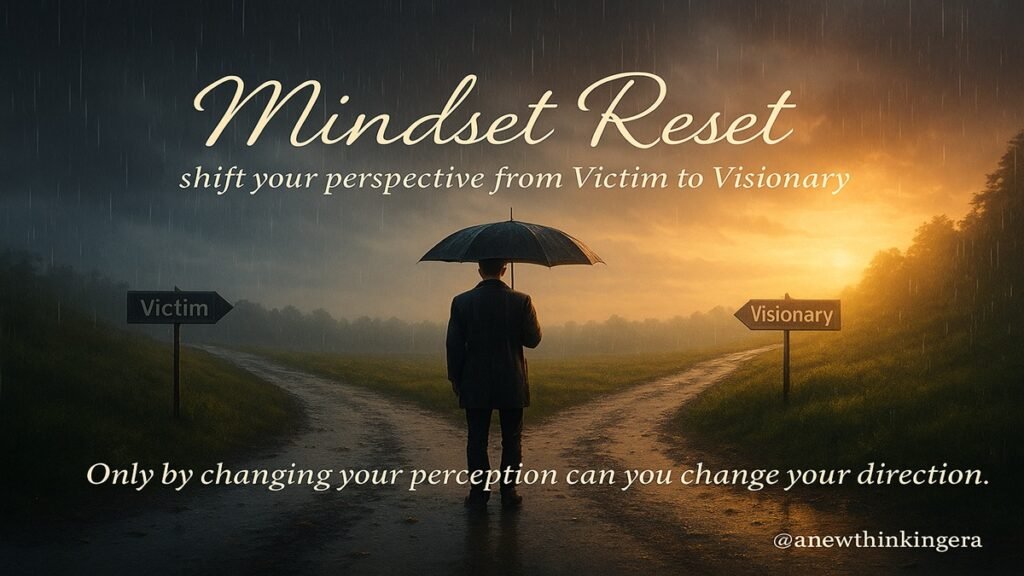
How to Reset Your Mindset After Failure:
(I). Shift Your Perspective from Victim to Visionary Mindset:
The difference between people who stay broken and those who rise isn’t luck, it’s mindset. Stop replaying the scene of your loss, rewrite the story. Do personal transformation yourself. Build your self-confidence.
When life hurts, it’s easy to slip into the victim mindset but Instead of asking “Why did this happen to me?” start asking “What can this teach me?” That one question may changes the direction of your life.
Think of it this way, the same rain that ruins one person’s plans nourishes another’s crops. You can’t control the storm, but you can choose how to grow through it.
Why Perspective Changes Everything:
Your perspective acts like a lens. When the lens is fogged with self-pity or fear, even small problems feel insurmountable(impossible or invincible). But when you clean that lens with gratitude and reflection, your reality shifts, not because circumstances changed, but because you did.
Psychologists call this cognitive reframing, the art of seeing the same situation through a different emotional lens. It’s not denial; it’s redesign. You acknowledge the pain but also recognize your power to interpret it differently.
“The same storm that breaks others can also teach you how to sail.”
From Reaction to Redirection:
Ask youself. Do you want to be victim or visionary?
The victim says, “I can’t control what happened.”
The visionary says, “I can control what happens next.”
Every setback holds hidden resources, time to reflect, lessons about people, or a chance to rebuild on stronger values. When you focus on these gifts, you move from helplessness to direction, from being acted upon to becoming the author of your next chapter.
“The visionary doesn’t deny pain; they design meaning from it.“
Informative Table: Victim vs Visionary Mindset (Turning Pain into Power)
| Mindset Element | Victim Perspective | Visionary Perspective | Practical Reset Tip |
|---|---|---|---|
| Core Belief | “Life happens to me.” | “Life happens for me.” | Replace complaints with gratitude. |
| Focus Point | Problems, blame, and loss. | Possibilities, learning, and growth. | List 3 lessons every time you fail. |
| Emotional State | Drained, defensive, fearful. | Calm, curious, creative. | Pause before reacting; breathe and reframe. |
| Response to Failure | “Why me?” → feels powerless. | “What now?” → acts with purpose. | Journal one empowering action daily. |
| Self-Image | Controlled by circumstances. | Creator of new direction. | Repeat affirmations: “I design my story.” |
| Use of Pain | Proof of defeat. | Fuel for reinvention. | Turn regrets into learning plans. |
| Goal Orientation | Avoid failure, seek comfort. | Embrace challenge, pursue meaning. | Set one bold weekly challenge. |
| Energy Source | Validation from others. | Inspiration from within. | Limit comparison, focus on growth. |
| Time Outlook | Stuck in the past. | Focused on the future. | Visualize where this pain will lead you. |
| Mantra | “I can’t change anything.” | “I can change everything — starting now.” | Say this aloud every morning. |
How to Practice the Visionary Shift and remove yourself from feeling like a victim:
- Pause Before You React: When failure hits, don’t rush. Breathe. Observe your emotions before they define you.
- Ask Better Questions: Replace “Why me?” with “What now?” and “What can I learn from this?”
- Create a Future Focus: Write one line daily describing the life you’re rebuilding, not the one you lost.
- Surround Yourself with Builders: Seek people who talk solutions, not scars.
- Remember Your Role: You’re not the story’s victim; you’re its author. Every edit makes it stronger.
(II). The Power of Self-Talk: Rewriting the Voice That Shapes Your Reality
When failure strikes, the loudest voice isn’t the world’s, it’s your own voice. The words you whisper to yourself in silence can either destroy your spirit or rebuild your courage. This is where the power of self-talk becomes your greatest inner tool.
Every thought you repeat creates an emotional echo in your body. Tell yourself “I can’t,” and your brain shuts down possibility. Say “I’ll try,” and it re-opens the neural doors to creativity, confidence, and problem-solving.
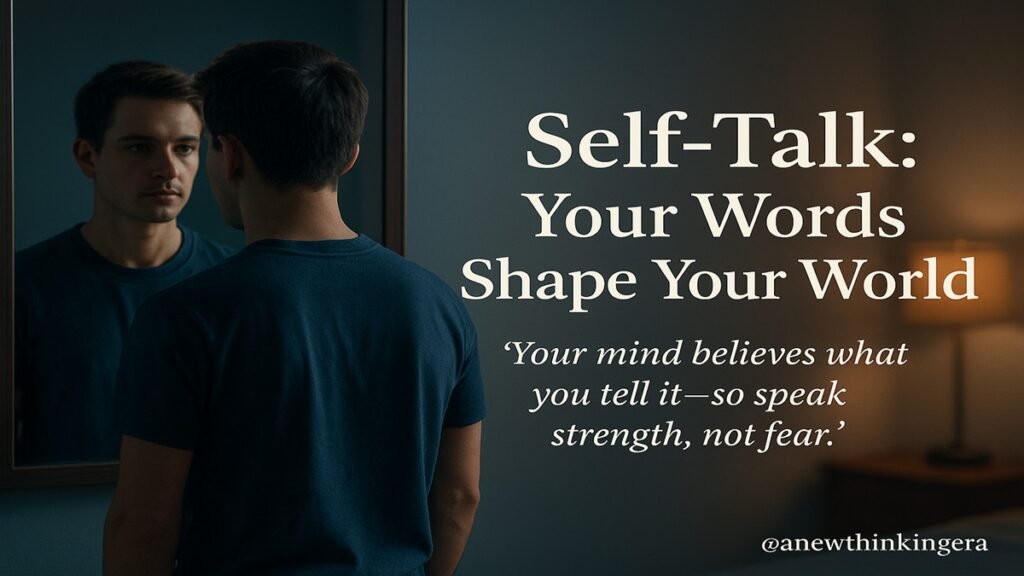
Science calls this the “neuro-linguistic loop” — the way language influences your brain chemistry, energy, and performance. “Your inner voice becomes the architect of your outer world.” Replace thoughts like “I’m finished” with This is my reset.”
Write affirmations that feel true and Rewire your Brain through Self-Talk:
- “Every ending is guiding me to something new.”
- “I choose progress over perfection.”
- “I am rebuilding with purpose.”
How Self-Talk Shapes Our Mind and Mood:
Studies in cognitive psychology and neuroscience reveal that positive self-talk activates the prefrontal cortex, the brain’s decision center, while reducing the stress response in the amygdala. This means when you change your words, you literally change your emotional state and behavior.
” Your brain listens to every word you say , speak like someone you want to become.“
When you say, “I’ll find a way,” your subconscious begins searching for solutions instead of rehearsing problems. Repeated affirmations of belief release dopamine, the brain’s motivation chemical, reminding you that effort is never wasted.
Daily Practice for how to Rebuild Life After Failure: 3 Minutes to Reset Your Self-Talk
- Morning Mirror Talk – Look into your reflection and say one line that empowers you. (“I am capable and ready for today.”)
- Evening Reflection/Self-Talk – Replace regret with gratitude. (“I did my best with what I knew.”)
- Crisis Reminder – When overwhelmed, breathe and repeat: “This feeling is temporary; my strength is permanent.”
Why Self-Talk is the Foundation of Resilience:
You cannot control what life says to you, but you can control what you say back. Self-talk is the language of your resilience — it turns chaos into clarity and fear into forward motion. When your inner voice becomes your ally, failure no longer defines you; it refines you.
Transforming Negative Self-Talk into Empowering Language
| Negative Thought | Reframed Self-Talk |
|---|---|
| “I always mess things up.” | “I’m still learning how to get it right.” |
| “I failed again.” | “This was feedback, not final.” |
| “I’m not good enough.” | “I’m growing into the person I’m meant to be.” |
| “It’s too late for me.” | “Every sunrise gives me another chance.” |
By catching and reframing your thoughts in real time, you train your brain to expect better outcomes.
This isn’t denial, it’s mental discipline. Just as muscles grow through repetition, confidence grows through consistent, compassionate inner dialogue.
(III). The Science of Resilience-Why Some People Rise Faster After Failure
Psychologists call it post-traumatic growth — the ability to become stronger because of adversity, not despite it.Your brain actually rewires itself when you practice gratitude, reflection, and small daily wins. Each day you show up again, you’re forming new neural pathways of strength.
When life breaks you down, resilience is what helps you rise again — not by ignoring pain, but by adapting through it. Modern psychology defines resilience as the ability to bounce back from setbacks while maintaining emotional balance and purpose.
It isn’t a gift reserved for a few strong souls; it’s a skill the brain can strengthen with practice.
Do You know: How Resilience Works in the Brain
Scientific research shows that the prefrontal cortex (the part of the brain responsible for reasoning and control) and the amygdala (the emotional response center) work like partners during stress.
When you practice optimism, mindfulness, or gratitude, your prefrontal cortex sends calming signals that reduce fear and anxiety. This process, known as neuroplasticity, literally rewires the brain — helping you recover faster and build emotional endurance.
“Every time you choose to reflect instead of react, your brain strengthens the neural pathways of strength.“
Habits That Build Everyday Resilience Mindset:
- Micro-Recovery Moments: Pause for deep breathing or journaling, even a few minutes calm your stress response.
- Reframe the Narrative: Instead of “I failed,” think “I learned.” This small linguistic shift boosts serotonin and self-belief.
- Connection Over Isolation: Talking about your pain with a trusted friend increases oxytocin — your body’s natural stress antidote.
- Movement & Sleep: Exercise and rest help the brain process stress hormones and restore focus.
- Purpose Practice: Doing small meaningful acts, mentoring, volunteering, helping others — anchors resilience in compassion.
Why Resilience is the Real Superpower
Resilience doesn’t mean never breaking; it means learning how to bend and still move forward.
People with resilient mindsets don’t avoid pain, they use it as data, growth, and creative energy.
When failure visits again (and it will), you’ll be ready , not because life gets easier, but because you become stronger.
3. Real Stories of Reinvention
Every great comeback begins in silence — in those private moments when no one’s watching, but your soul refuses to give up. These stories are proof that even when life seems to crumble, the human spirit knows how to rebuild, stronger, humbler, and wiser.
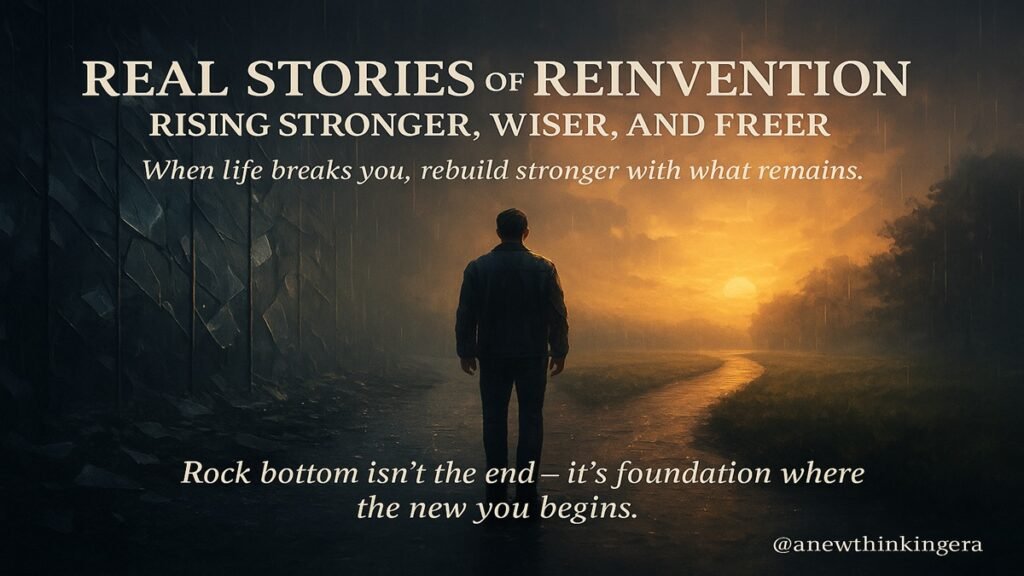
(I). Priya: The Athlete Who Learned to Run Again
Priya was once a national-level sprinter whose world revolved around the track. A severe leg injury during training ended her competitive career overnight. For months, she couldn’t even walk without support. But instead of surrendering, she redefined her purpose.
She began mentoring underprivileged girls who dreamed of sports but lacked access. Within two years, several of her trainees won district-level medals — something she calls her second victory lap.
Lesson: Pain often redirects you toward a greater purpose you couldn’t see before.
(II). Rohit: The Entrepreneur Who Lost Everything in Lockdown
Rohit poured his savings into a cozy café that became a local favorite — until a sudden lockdown closed it permanently. Months of hard work vanished, and depression took over.
One day, while scrolling through his phone, he found old videos of himself making coffee. That small moment sparked a new beginning.
He started a YouTube channel teaching coffee brewing techniques and life lessons about entrepreneurship. Within a year, he had over 200,000 subscribers — and brand collaborations that far surpassed his café income.
Lesson: Sometimes, failure is not your ending — it’s your redirection.
(III). Anuj — The Student Who Found Purpose Through Failure
When Anuj failed his board exams, he thought his life was over. The humiliation from relatives and pressure from society pushed him into isolation.
But while helping a classmate understand math, he realized he had a gift for teaching. That one act reshaped his destiny.
Today, Anuj runs a successful coaching center for students who struggle academically, helping hundreds turn shame into strength. Failure doesn’t define your intelligence, your perseverance does.
Lesson: What feels like your biggest setback may actually be your soul’s real calling.
(IV). Neha — The Executive Who Chose Inner Peace Over Prestige
Neha had climbed the corporate ladder fast, earning promotions and applause — until burnout brought her to tears at her desk one night. Instead of chasing another title, she took a sabbatical to rediscover her values.
During her break, she began blogging about mental health and work-life balance. Her words resonated with thousands. Today, she’s a full-time writer and wellness coach — living with balance, not burnout.
Lesson: Sometimes success means slowing down to meet yourself again.
What These Stories Teach Us
Resilience isn’t just about bouncing back; it’s about bouncing forward. Each of these people faced moments that could have defined them as victims — but they chose to become visionaries of their own story.
Their courage teaches us one truth — you don’t rebuild the old life; you design a new one from what you’ve learned.
” Your story isn’t over , it’s just waiting for a rewrite.“
4. Practical Steps to Rebuild Your Life
When life falls apart, rebuilding can feel overwhelming. Start small, like placing one brick each day. Rebuilding your life after failure can feel like standing in front of a collapsed home, unsure where to begin. But every new foundation starts with one brick.
Failure often damages self-belief, but new knowledge repairs it. Enroll in a course, read something inspiring, learn a new skill — not to prove yourself, but to remind yourself that you’re capable of growth. Confidence doesn’t come from applause; it comes from progress.
” When you learn again, you live again.“
These practical, science-backed, and heart-driven steps will help you restore balance, confidence, and meaning.
Here’s a practical roadmap:
| Step | Action | Example |
|---|---|---|
| 1 | Accept & Reflect | Write what happened without blaming yourself or others. |
| 2 | Reconnect with Purpose | Ask: “What truly matters to me now?” |
| 3 | Create a Small-Wins Plan | 1% progress each day — one call, one page, one step. |
| 4 | Rebuild Confidence | Learn a new skill, volunteer, or teach someone else. |
| 5 | Guard Your Energy | Stay away from negativity — people or thoughts that drain you. |
Success doesn’t come from one giant leap — it comes from thousands of tiny steps taken in the right direction.
5. Emotional Recovery/Healing & Self-Care Rituals
(I) Letting Go Through Writing
Writing helps you organize your emotions into meaning. Start journaling at night — not to judge, but to release. Write what you’re grateful for and what you’re learning.
Pro tip: Create a “healing notebook” or download a journaling app. Write one victory a day, no matter how small.
(II) Therapy & Support Circles
Asking for help isn’t weakness — it’s wisdom. Counselors, mentors, or even an honest friend can offer new perspectives that you can’t see from the middle of pain.
(II) Mind-Body Reconnection
Simple acts, a walk at sunrise, deep breathing, mindful eating, help your nervous system feel safe again. Healing doesn’t always look grand; sometimes it’s just you sitting quietly, choosing peace.
6. Rewriting Your Story — Meet the New You
Failure breaks the version of you that wasn’t meant to last. The new you begins when you decide the story isn’t over.
Try this exercise:
Write a letter from your future self — imagine it’s five years from now, and you’re thriving.
Thank yourself for not quitting today. Describe how proud you are of the choices you made when everything seemed dark.
This exercise builds emotional momentum and helps your mind visualize success before it happens.
7. Powerful Motivational Quotes to Uplift Your Comeback From Failure
“Rock bottom became the solid foundation on which I rebuilt my life.” — J.K. Rowling
Sometimes the floor you fall on becomes the base of your best chapter.
“Our greatest glory is not in never falling, but in rising every time we fall.” — Confucius
Falling is proof you’re trying.
“Failure is simply the opportunity to begin again, this time more intelligently.” — Henry Ford
Each setback is data for your next design.
“It’s not whether you get knocked down; it’s whether you get up.” — Vince Lombardi
“When everything seems lost, remember — seeds grow in darkness before they bloom in light.” — Unknown
You can even make a “Quotes Corner” journal — one quote each morning to refuel your courage.
8. Real-Life Reflection Exercise
Take a quiet moment after reading this section:
- Write down three failures that still haunt you.
- Next to each, write one gift or lesson it brought you.
- Circle the one lesson you want to build on this month.
This reflection rewires your mind to see growth where you once saw grief.
9. Conclusion: Every Ending Is a Beginning in Disguise
Starting over isn’t about erasing the past, it’s about embracing what it taught you. You’re not the same person who began this journey, you’re wiser, softer, stronger.
Life will break you, yes. But those cracks aren’t flaws, they are where the light enters. The courage to begin again is the quiet miracle that turns survivors into legends.
So, if today you’re standing at the edge of what feels like an ending, breathe, smile, and take that first step forward. You are not behind. You are becoming.
Mini Call-to-Action
Hey, Readers.
Share your own “starting over” story in the comments , your journey might be someone else’s reason to hope.
FAQ Section:
Q1. What does it really mean to start over after failure?
Starting over means letting go of the version of yourself that failed and building a wiser one with the lessons learned.
It’s not about erasing the past — it’s about evolving from it. You pause, reflect, and take small but intentional steps toward a life shaped by purpose, not regret.
Q2. How can I rebuild confidence after a major setback?
Confidence returns when you collect small daily wins. Set achievable goals, track your progress, and celebrate effort — not perfection.
Surround yourself with encouraging voices and practice self-talk that reinforces strength instead of self-criticism.
Q3. What is the science of resilience and how does it help recovery?
The science of resilience explores how the brain and emotions adapt under pressure.
With repeated positive habits — like mindfulness, gratitude, and social support — your brain forms new neural connections that reduce anxiety and strengthen emotional control.
This process, called neuroplasticity, allows you to heal and move forward with greater balance.
Q4. Why do some people handle failure better than others?
Resilience isn’t luck — it’s a combination of mindset, environment, and daily practices.
People who reflect instead of react, stay connected to others, and focus on learning rather than blaming tend to recover faster.
In short, they don’t see failure as an end — they see it as feedback.
Q5. How long does it take to emotionally recover from failure?
There’s no fixed timeline; recovery depends on how deeply the event affected you and how actively you process it.
However, consistent reflection, healthy routines, and goal-based action often bring visible emotional stability within weeks or months.
Q6. Can failure ever be good for personal growth?
Absolutely. Failure often reveals your limits, false priorities, and untapped potential.
Every failure leaves behind valuable data — what doesn’t work and what truly matters.
When you analyze and apply those lessons, failure becomes your most honest teacher.
Q7. What’s the first step to rebuilding life after failure?
The first step is acceptance — acknowledging what happened without denial or blame.
Once acceptance sets in, reflection and planning follow naturally.
From there, you rebuild piece by piece — not rushing, but progressing steadily toward renewal.
Q8. How can mindfulness help in starting over?
Mindfulness grounds you in the present, preventing overthinking about what’s lost or uncertain.
It helps calm your emotional reactions, improves focus, and allows you to see situations more clearly — essential traits when rebuilding after failure.
Q9. Is it normal to feel lost even after making progress?
Yes, it’s perfectly normal. Healing isn’t linear.
You may feel hopeful one day and doubtful the next — but these fluctuations are signs of growth, not regression.
The key is consistency; keep moving forward even when clarity seems distant.
Q10. What books or resources can help strengthen resilience and mindset?
- Man’s Search for Meaning – Viktor E. Frankl
- The Obstacle Is the Way – Ryan Holiday
- Daring Greatly – Brené Brown
- Atomic Habits – James Clear
- The Power of Now – Eckhart Tolle
Each of these works explores courage, acceptance, and the power of inner transformation.
Disclaimer
The information presented in this article, “The Art of Starting Over: How to Rebuild Life After Failure with Strength & Grace,” is intended for educational and motivational purposes only. It does not substitute for professional advice, therapy, counseling, or medical guidance. Every reader’s situation is unique, and results may vary based on personal circumstances and actions. If you are experiencing mental health concerns, trauma, or severe emotional distress, please consult a qualified psychologist, counselor, or mental health professional. The author and A New Thinking Era assume no responsibility for outcomes resulting from actions taken based on this content. By reading and using this article, you agree to apply discretion and seek professional help where necessary.

